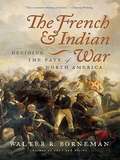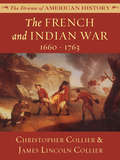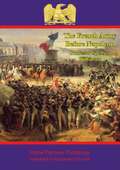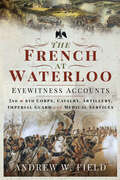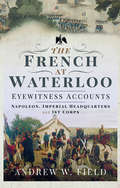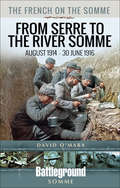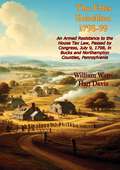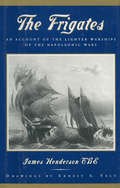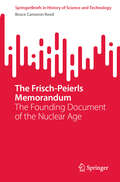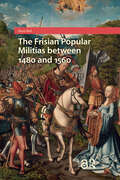- Table View
- List View
The French House: The captivating and heartbreaking wartime love story and Richard & Judy Book Club pick
by Jacquie Bloese'I absolutely loved this powerful and sweeping story. I was completely immersed in the lives of these characters, with them at every heart-pounding moment, and felt the tears running down my cheeks at the end' Reader review ⭐ ⭐ ⭐ ⭐ ⭐ In Nazi-occupied Guernsey, the wrong decision can destroy a life... Left profoundly deaf after an accident, Émile is no stranger to isolation - or heartbreak. Now, as Nazi planes loom over Guernsey, he senses life is about to change forever.Trapped in a tense, fearful marriage, Isabelle doesn't know what has become of Émile and the future she hoped for. But when she glimpses him from the window of the French House, their lives collide once more. Leutnant Schreiber is more comfortable wielding a paintbrush than a pistol. But he has little choice in the role he is forced to play in the occupying forces - or in his own forbidden desires. As their paths entwine, loyalties are blurred and dangerous secrets forged. But on an island under occupation, courage can have deadly consequences... Lyrical, moving and compelling, this is a novel about the price we pay for love and the courage of individuals in the face of war. Perfect for fans The Nightingale, The Guernsey Literary and Potato Peel Pie Society and All the Light We Cannot See.Everyone is falling in love with The French House:'I cannot put into words how good this book is... A gripping and emotive storyline and well-developed characters that all brought something different to the page and that I have taken to my heart. I loved it' Reader review ⭐ ⭐ ⭐ ⭐ ⭐ 'A raw and honest love story, filled with a wealth of historical detail. The French House is a powerful depiction of the brutal intricacies of island relationships and loyalties in a time of war' Fiona Valpy 'Deeply involving . . . A fantastic debut by a gifted storyteller' Jill Mansell 'Quite simply wonderful. From the moment I started reading I knew I was unwrapping a big story. The writing is so gorgeous, so evocative and so wonderfully paced' Reader review ⭐ ⭐ ⭐ ⭐ ⭐ 'An absolutely stunning, beautifully original novel' Jenny Ashcroft 'A beautifully wrought exploration of love of all kinds. It's utterly gorgeous, convincingly written and completely captivating. Make sure you read it' My Weekly 'A very moving read... The underlying love story is moving as is the loyalty and bravery of the people. A brilliant read that I can highly recommend 5* doesn't seem enough' Reader review ⭐ ⭐ ⭐ ⭐ ⭐ 'A story of fraught secrets and tested loyalties . . . I found this beautifully told tale hard to put down' Anita Frank'Heart-wrenching . . . A truly special novel' Louise Fein 'A fabulous, emotional love story set against the backdrop of the German Occupation of Guernsey during World War Two... I absolutely loved it!' Reader review ⭐ ⭐ ⭐ ⭐ ⭐
The French House: The captivating and heartbreaking wartime love story and Richard & Judy Book Club pick
by Jacquie Bloese'I absolutely loved this powerful and sweeping story. I was completely immersed in the lives of these characters, with them at every heart-pounding moment, and felt the tears running down my cheeks at the end' Reader review ⭐ ⭐ ⭐ ⭐ ⭐ In Nazi-occupied Guernsey, the wrong decision can destroy a life... Left profoundly deaf after an accident, Émile is no stranger to isolation - or heartbreak. Now, as Nazi planes loom over Guernsey, he senses life is about to change forever.Trapped in a tense, fearful marriage, Isabelle doesn't know what has become of Émile and the future she hoped for. But when she glimpses him from the window of the French House, their lives collide once more. Leutnant Schreiber is more comfortable wielding a paintbrush than a pistol. But he has little choice in the role he is forced to play in the occupying forces - or in his own forbidden desires. As their paths entwine, loyalties are blurred and dangerous secrets forged. But on an island under occupation, courage can have deadly consequences... Lyrical, moving and compelling, this is a novel about the price we pay for love and the courage of individuals in the face of war. Perfect for fans The Nightingale, The Guernsey Literary and Potato Peel Pie Society and All the Light We Cannot See.Everyone is falling in love with The French House:'I cannot put into words how good this book is... A gripping and emotive storyline and well-developed characters that all brought something different to the page and that I have taken to my heart. I loved it' Reader review ⭐ ⭐ ⭐ ⭐ ⭐ 'A raw and honest love story, filled with a wealth of historical detail. The French House is a powerful depiction of the brutal intricacies of island relationships and loyalties in a time of war' Fiona Valpy 'Deeply involving . . . A fantastic debut by a gifted storyteller' Jill Mansell 'Quite simply wonderful. From the moment I started reading I knew I was unwrapping a big story. The writing is so gorgeous, so evocative and so wonderfully paced' Reader review ⭐ ⭐ ⭐ ⭐ ⭐ 'An absolutely stunning, beautifully original novel' Jenny Ashcroft 'A beautifully wrought exploration of love of all kinds. It's utterly gorgeous, convincingly written and completely captivating. Make sure you read it' My Weekly 'A very moving read... The underlying love story is moving as is the loyalty and bravery of the people. A brilliant read that I can highly recommend 5* doesn't seem enough' Reader review ⭐ ⭐ ⭐ ⭐ ⭐ 'A story of fraught secrets and tested loyalties . . . I found this beautifully told tale hard to put down' Anita Frank'Heart-wrenching . . . A truly special novel' Louise Fein 'A fabulous, emotional love story set against the backdrop of the German Occupation of Guernsey during World War Two... I absolutely loved it!' Reader review ⭐ ⭐ ⭐ ⭐ ⭐
The French House: The most captivating World War Two love story of 2022
by Jacquie BloeseFreedom worth fighting for. Love worth waiting for.In Nazi-occupied Guernsey, the consequences of making the wrong decision can be deadly...Left profoundly deaf after an accident, Émile is no stranger to isolation - or heartbreak. Now, as Nazi planes loom over Guernsey, he senses life is about to change forever.Trapped in a tense, fearful marriage, Isabelle doesn't know what has become of Émile and the future she hoped for. But when she glimpses him from the window of the French House, their lives collide once more. Leutnant Schreiber is more comfortable wielding a paintbrush than a pistol. But he has little choice in the role he is forced to play in the occupying forces - or in his own forbidden desires. As their paths entwine, loyalties are blurred and dangerous secrets forged. But on an island under occupation, courage can have deadly consequences...Lyrical, moving and compelling, this is a novel about wanting to hear and learning to listen - to the truths of our own hearts.(P) 2022 Hodder & Stoughton Limited
The French Indochina War 1946-54
by Martin Windrow Mike ChappellThe states of Indochina had been French colonies or protectorates since the 19th century. However, in March 1945 the Japanese interned all French troops and officials, and turned over all civil government to local authorities. The power vacuum caused by the Japanese surrender allowed the Viet Minh, a strong revolutionary organisation, to be established throughout Vietnam. When the French returned to the north, incidents between French and VM troops were inevitable, negotiations collapsed and the French opted for a military solution. This book examines the history of the conflict and the forces of both sides of the French Indochina War (1946-1954).
The French Photographer: This Winter Go To Paris, Brave The War, And Fall In Love
by Natasha LesterFrom the INTERNATIONALLY BESTSELLING author of The Paris Seamstress comes a story of courage, family and forgiveness from New York to war-torn Europe.Perfect for fans of Kate Furnivall, Lucinda Riley, Kate Morton and Gill Paul'Divine' GILL PAUL, bestselling author of The Secret Wife'An emotional and sweeping tale' CHANEL CLEETON, bestselling author of Next Year in Havana 'A splendid, breathtaking novel, full of mystery and passion...a must read!' JEANNE MACKIN, author of The Last Collection********1942When Jessica May's successful modelling career is abruptly cut short, Vogue send her to war-torn Paris to cover the conflict as a correspondent. She's courageous and a fast-learner, but of course the military men make her life as difficult as possible.Three friendships change that: journalist Martha Gellhorn encourages Jess to bend the rules; paratrooper Dan Hallworth shows her how to take pictures and write stories that matter; and a little girl, Victorine, who shows Jess how to open hear heart. 2005Australian curator D'Arcy Hallworth arrives at a beautiful French chateau to manage a famous collection of photographs. What begins as just another job becomes far more disquieting as D'Arcy uncovers the true identity of the mysterious French photographer... MORE PRAISE FOR NATASHA LESTER:'A fantastically engrossing story. I love it' KELLY RIMMER'A beautiful story in every way' THE LADY'Intrigue, heartbreak... I cannot tell you how much I loved this book' RACHEL BURTON'If you enjoy historical fiction (and even if you don't) you will love this book' SALLY HEPWORTH'A gorgeously rich and romantic novel' KATE FORSYTH'Stunning . . . Will have you captivated' LIZ BYRSKI'Exquisite!' VANESSA CARNEVALE'Emotion that will touch your heart and soul deeply' JODI GIBSON'Fascinating, evocative and meticulously researched' ANNABEL ABBS
The French Photographer: This Winter Go To Paris, Brave The War, And Fall In Love
by Natasha LesterFrom the INTERNATIONALLY BESTSELLING author of The Paris Seamstress comes a story of courage, family and forgiveness from New York to war-torn Europe.Perfect for fans of Kate Furnivall, Lucinda Riley, Kate Morton and Gill Paul'Divine' GILL PAUL, bestselling author of The Secret Wife'An emotional and sweeping tale' CHANEL CLEETON, bestselling author of Next Year in Havana 'A splendid, breathtaking novel, full of mystery and passion...a must read!' JEANNE MACKIN, author of The Last Collection********1942When Jessica May's successful modelling career is abruptly cut short, Vogue send her to war-torn Paris to cover the conflict as a correspondent. She's courageous and a fast-learner, but of course the military men make her life as difficult as possible.Three friendships change that: journalist Martha Gellhorn encourages Jess to bend the rules; paratrooper Dan Hallworth shows her how to take pictures and write stories that matter; and a little girl, Victorine, who shows Jess how to open hear heart.2005Australian curator D'Arcy Hallworth arrives at a beautiful French chateau to manage a famous collection of photographs. What begins as just another job becomes far more disquieting as D'Arcy uncovers the true identity of the mysterious French photographer... MORE PRAISE FOR NATASHA LESTER:'A fantastically engrossing story. I love it' KELLY RIMMER'A beautiful story in every way' THE LADY'Intrigue, heartbreak... I cannot tell you how much I loved this book' RACHEL BURTON'If you enjoy historical fiction (and even if you don't) you will love this book' SALLY HEPWORTH'A gorgeously rich and romantic novel' KATE FORSYTH'Stunning . . . Will have you captivated' LIZ BYRSKI'Exquisite!' VANESSA CARNEVALE'Emotion that will touch your heart and soul deeply' JODI GIBSON'Fascinating, evocative and meticulously researched' ANNABEL ABBS
The French Resistance
by Olivier WieviorkaOlivier Wieviorka's history of the French Resistance debunks lingering myths and offers fresh insight into social, political, and military aspects of its operation. He reveals not one but many interlocking homegrown groups often at odds over goals, methods, and leadership. Yet, despite a lack of unity, these fighters braved Nazism without blinking.
The French Revolution: A Very Short Introduction
by William DoyleBeginning with a discussion of familiar images of the French Revolution, garnered from Dickens, Baroness Orczy, and Tolstoy, as well as the legends of let them eat cake, and tricolours, Doyle leads the reader to the realization that we are still living with developments and consequences of the French Revolution such as decimalization, and the whole ideology of human rights. Continuing with a brief survey of the old regime and how it collapsed, Doyle continues to elucidate how the revolution happened: why did the revolutionaries quarrel with the king, the church and the rest of Europe, why this produced terror, and finally how it accomplished rule by a general. The revolution destroyed the age-old cultural, institutional and social structures in France and beyond. This book looks at how the ancient regime became ancient as well as examining cases in which achievement failed to match ambition. Doyle explores the legacy of the revolution in the form of rationality in public affairs and responsible government, and finishes his examination of the revolution with a discussion as to why it has been so controversial.
The French Winemaker's Daughter: A Novel
by Loretta EllsworthSet during World War II, an unforgettable historical novel about love, war, family, and loyalty told in in the voices of two women, generations apart, who find themselves connected by a mysterious and valuable bottle of wine stolen by the Nazis.1942. Seven-year-old Martine hides in an armoire when the Nazis come to take her father away. Pinned to her dress is a note with her aunt’s address in Paris, and in her arms, a bottle of wine she has been instructed to look after if something happened to her papa. When they are finally gone, the terrified young girl drops the bottle and runs to a neighbor, who puts her on a train to Paris.But when Martine arrives in the city, her aunt is nowhere to be found. Without a place to go, the girl wanders the streets and eventually falls asleep on the doorstep of Hotel Drouot, where Sister Ada finds her and takes her to the abbey, and watches over her.1990. Charlotte, a commercial airline pilot, attends an auction with her boyfriend Henri at Hotel Drouot, now the oldest auction house in Paris. Successfully bidding on a box of wine saved from the German occupation during the Second World War, Henri gives Charlotte a seemingly inferior bottle he finds inside the box. Cleaning the label, Charlotte makes a shocking discovery that sends her on a quest to find the origins of this unusual—and very valuable—bottle of wine, a quest that will take her back fifty years into the past. . . .A powerful tale of love, war, and family, The French Winemaker’s Daughter is an emotionally resonant tale of two women whose fates are intertwined across time. Loretta Ellsworth’s evocative and poignant page-turner will linger in the heart, and make you think about luck, connection, and the meaning of loyalty.
The French and Indian War
by Walter R. BornemanIn the summer of 1754, deep in the wilderness of western Pennsylvania, a very young George Washington suffered his first military defeat, and a centuries-old feud between Great Britain and France was rekindled. The war that followed would be fought across virgin territories, from Nova Scotia to the forks of the Ohio River, and it would ultimately decide the fate of the entire North American continent--not just for Great Britain and France but also for the Spanish and Native American populations. Noted historian Walter R. Borneman brings to life an epic struggle for a continent--what Samuel Eliot Morison called "truly the first world war"--and emphasizes how the seeds of discord sown in its aftermath would take root and blossom into the American Revolution.
The French and Indian War: 1660 - 1763
by James Lincoln Collier Christopher CollierHistory is dramatic -- and the renowned, award-winning authors Christopher Collier and James Lincoln Collier demonstrate this in a compelling series aimed at young readers. Covering American history from the founding of Jamestown through present day, these volumes explore far beyond the dates and events of a historical chronicle to present a moving illumination of the ideas, opinions, attitudes and tribulations that led to the birth of this great nation. Using clear and descriptive language, The French and Indian War outlines the period in which the American colonies were settled and explains how European politics helped cause the French and Indian War. Beginning in the 1670s, when England, France, Spain, the Netherlands, and Sweden all had laid claim to parts of the New World, the authors describe the evolution of the various colonies, and their relationships with each other, the Indians, and the different European governments. The inevitable conflicts led to the titular power struggle between the French and the English, ending with the 1763 Treaty of Paris, in which France gave up its claims in North America. The text is enhanced with images of historical artifacts, works by contemporary artists, and photographs of reenacted scenes.
The French army before Napoleon: lectures delivered before the University of Oxford in Michaelmas term, 1914
by Professor Spenser WilkinsonMany know of the French army that marched under Napoleon's eagles to triumph after triumph before the Emperor's last gamble failed at Waterloo. However, the army that drove the French all the way to Moscow was victorious in many battles in previous wars, and at its heart were the noble officers. The theories and insights of the officer corps shaped the thinking of all of Europe, not least the strategic thinking of Napoleon. Professor Wilkinson charts the advances in tactics and the progression of thought within the military circles of France that would dominate not only the French themselves, but all of their opponents.Professor Spenser Wilkinson had a long and illustrious career as a military historian including holding the seat of Chichele Professor of Military History of Oxford.Author -- Professor Spenser Wilkinson (1853-1937)Text taken, whole and complete, from the edition published in Oxford, Clarendon press, 1915.Original Page Count -- 151 pages.
The French at War, 1934-1944 (Seminar Studies)
by Nicholas AtkinThe years 1934 to 1944 remain the most contentious and dramatic decade in modern French history. Covering the Occupation, the Vichy regime, the Resistance and collaboration, Nick Atkin provides an important introduction to this key period. Accessible and concise, the book offers a wide-ranging synthesis of key themes and events. Looking ahead to the present day, the book also examines how the French establishment and public have coped with the legacy of Vichy, and explains why the occupation is still ever present in French politics and everyday life.
The French at Waterloo—Eyewitness Accounts: 2nd and 6th Corps, Cavalry, Artillery, Foot Guard and Medical Services
by Andrew W. FieldThis invaluable record presents newly translated, firsthand accounts of Waterloo from French soldiers who fought on the frontline.With this volume, Andrew Field completes his pioneering work on the French experience in this decisive battle. Readers can now engage with these vivid, ground-level accounts and compare them to the narratives based largely on the British perspective. They will also gain new insight into the trauma that the French experienced on the battlefield and afterward.This volume follows The French at Waterloo—Eyewitness Accounts: Napoleon, Imperial Headquarters, and 1st Corps. It features graphic descriptions of the battle as remembered by men of the 2nd and 6th corps, cavalry, artillery and Imperial Guard and medical services of Napoleon’s army. Their words give us not only an inside view their actions, but they also record in graphic detail what they saw and how they reacted to Napoleon’s historic defeat.
The French at Waterloo—Eyewitness Accounts: Napoleon, Imperial Headquarters and 1st Corps (The French at Waterloo: Eyewitness Accounts)
by Andrew W. FieldThe military historian and expert on the Waterloo campaign presents a fascinating selection of firsthand accounts never before published in English.Andrew Field has written several important volumes on the Battle of Waterloo from the French perspective. Now he takes his pioneering work a step further by publishing these accounts, with all their vivid and personal detail, in full. This volume features Napoleons own description of the battle, as well as those of his immediate household, the Imperial headquarters, and members of 1st Corps. Readers can now engage with these crucial firsthand perspectives and compare them to those of the allied armies. They will also gain insight into the trauma that the French eyewitnesses went through as they tried to explain how they lost a battle they claim they had been on the point of winning.Napoleons own version of events, one of the first to be published in France, was used as the basis of many subsequent histories that ignore or gloss over his many dubious claims. His account of his actions on that decisive day, and the accounts of his close associates, make fascinating reading.
The French on the Somme: August 1914 – 30 June 1916: From Serre to the River Somme (Battleground Books: Wwi Ser.)
by David O'MaraFor many British visitors, the fighting in the Somme starts on 1 July 1916 and few consider what happened in the area before the British took over the line, part in later 1915 and some in 1916.In fact there was extensive fighting during the opening phase of he war, as both the French and Germans tried to outflank each other. Through the autumn and winter there was a struggle to hold the best tactical ground, with small scale but ferocious skirmishes from Beaumont Hamel to the Somme.The conflict in what became known as the Glory Hole, close to the well known Lochnagar Crater, was particularly prolonged. Evidence of the fighting, mainly in the form of a large mine crater field, is visible today. The underground war was not confined to la Boisselle, with a similar crater field developing on Redan Ridge; whilst south of the Somme, to be covered in a future volume, great lengths of No Man's Land were dominated by mine craters.Serre, best known to British readers for its association with the Pals Battalions on 1 July 1916, witnessed a significant, if local, French offensive in June 1915, with casualties running into the several thousands. It is a battle that has left its mark on the landscape today, with a French national cemetery and a commemorative chapel acting as memorials to the battle.The book is introduced by a chapter describing the role of the area in the Franco-Prussian War of 1870-71, a war which arguably provided the seed bed for the outbreak of war in 1914. Several battles were fought in Somme villages that were to become the victims of war all over again forty plus years later.
The French-German Dynamic in an Age of Conflict, 1925–1963: Enemies, Collaborators, Friends (Routledge Studies in Modern European History)
by Elana PassmanThis book investigates the radical transformation of the relationship between Germany and France, neighbors whose border constituted one of the deepest fault lines of European history.For generations, the French and the Germans believed they were “eternal enemies,” and this myth of primordial hatred was the lens through which they interpreted each other’s every move. Yet today, a Franco-German war is unimaginable. Passman locates the reshaping of the French-German dynamic in the civic organizations that made the very notion of cooperation credible. After World War I, and in the decades to follow, Franco-German associations kept calling for an end to their animus. Through journals, cultural exchanges, events, and charitable ventures, activists opened up the possibility of imagining friendship with the enemy. The pursuit of French-German cooperation did not begin with politicians after World War II. It took flight in the 1920s and persisted through decades of turmoil. In anchoring the history of collaboration in a longer arc of French-German cooperation, Passman illuminates how entangled were the histories of 1920s rapprochement, Nazi-era collaborationism, and postwar reconciliation.This volume will appeal to scholars, students, and general readers interested in the histories of modern France and modern Germany, European integration, and peace studies.
The Frequency of Us: A BBC2 Between the Covers book club pick
by Keith StuartA BBC2 BETWEEN THE COVERS BOOK CLUB PICK'A fascinating, beautiful, heartwarming novel. It kept me gripped from the very first chapter' -- BETH O'LEARYIn Second World War Bath, young, naïve wireless engineer Will meets Austrian refugee Elsa Klein: she is sophisticated, witty and worldly, and at last his life seems to make sense . . . until, soon after, the newly married couple's home is bombed, and Will awakes from the wreckage to find himself alone.No one has heard of Elsa Klein. They say he was never married.Seventy years later, social worker Laura is battling her way out of depression and off medication. Her new case is a strange, isolated old man whose house hasn't changed since the war. A man who insists his wife vanished many, many years before. Everyone thinks he's suffering dementia. But Laura begins to suspect otherwise . . .From Keith Stuart, author of the much-loved Richard & Judy bestseller A Boy Made of Blocks, comes a stunning, emotional novel about an impossible mystery and a true love that refuses to die.'Enthralling, a real thing of beauty. Dazzling' -- JOSIE SILVER'The Frequency of Us is a novel with a bit of everything: a sweeping love story, wonderfully complex characters, and a sprinkling of the supernatural. I loved it, and know it'll stay with me for some time' -- CLARE POOLEY'A complete joy! An intelligent, intricate and emotive mystery' -- LOUISE JENSON
The Frequency of Us: A BBC2 Between the Covers book club pick
by Keith Stuart'Enthralling, a real thing of beauty. Dazzling' -- JOSIE SILVER In Second World War Bath, young, naïve wireless engineer Will meets Austrian refugee Elsa Klein: she is sophisticated, witty and worldly, and at last his life seems to make sense . . . until, soon after, the newly married couple's home is bombed, and Will awakes from the wreckage to find himself alone. No one has heard of Elsa Klein. They say he was never married. Seventy years later, social worker Laura is battling her way out of depression and off medication. Her new case is a strange, isolated old man whose house hasn't changed since the war. A man who insists his wife vanished many, many years before. Everyone thinks he's suffering dementia. But Laura begins to suspect otherwise . . .From Keith Stuart, author of the much-loved Richard & Judy bestseller A Boy Made of Blocks, comes a stunning, emotional novel about an impossible mystery and a true love that refuses to die.'A fascinating, beautiful, heartwarming novel. It kept me gripped from the very first chapter, and I was rooting for Will and Elsa with all my heart' -- BETH O'LEARY'The Frequency of Us is a novel with a bit of everything: a sweeping love story, wonderfully complex characters, and a sprinkling of the supernatural. I loved it, and know it'll stay with me for some time' -- CLARE POOLEY'A complete joy! An intelligent, intricate and emotive mystery' -- LOUISE JENSON
The Frequency of Us: A BBC2 Between the Covers book club pick
by Keith Stuart*** A BBC2 BETWEEN THE COVERS BOOK CLUB PICK ****** BBC RADIO 4 BOOK AT BEDTIME ***'A fascinating, beautiful, heartwarming novel. It kept me gripped from the very first chapter' -- BETH O'LEARYIn Second World War Bath, young, naïve wireless engineer Will meets Austrian refugee Elsa Klein: she is sophisticated, witty and worldly, and at last his life seems to make sense . . . until, soon after, the newly married couple's home is bombed, and Will awakes from the wreckage to find himself alone.No one has heard of Elsa Klein. They say he was never married.Seventy years later, social worker Laura is battling her way out of depression and off medication. Her new case is a strange, isolated old man whose house hasn't changed since the war. A man who insists his wife vanished many, many years before. Everyone thinks he's suffering dementia. But Laura begins to suspect otherwise . . .From Keith Stuart, author of the much-loved Richard & Judy bestseller A Boy Made of Blocks, comes a stunning, emotional novel about an impossible mystery and a true love that refuses to die.'Enthralling, a real thing of beauty. Dazzling' -- JOSIE SILVER'The Frequency of Us is a novel with a bit of everything: a sweeping love story, wonderfully complex characters, and a sprinkling of the supernatural. I loved it, and know it'll stay with me for some time' -- CLARE POOLEY'A complete joy! An intelligent, intricate and emotive mystery' -- LOUISE JENSON
The Fries Rebellion 1798-99; An Armed Resistance to the House Tax Law, Passed by Congress, July 9, 1798,: in Bucks and Northampton Counties, Pennsylvania
by William Watts Hart DavisUncover the dramatic and turbulent history of early American resistance with William Watts Hart Davis's The Fries Rebellion 1798-99: An Armed Resistance to the House Tax Law, Passed by Congress, July 9, 1798, in Bucks and Northampton Counties, Pennsylvania. This meticulously researched work delves into one of the lesser-known but significant uprisings in American history, offering a comprehensive account of the events and the people involved in the Fries Rebellion.Davis, a respected historian, provides a detailed narrative of the rebellion that erupted in response to the federal house tax imposed by Congress in 1798. Through vivid storytelling and thorough analysis, he brings to life the passionate resistance led by John Fries and the farmers of Bucks and Northampton Counties, Pennsylvania, who stood against what they viewed as an unjust and oppressive tax.The Fries Rebellion 1798-99 explores the socio-political context of the late 18th century, highlighting the tensions between rural communities and the federal government. Davis examines the motivations, strategies, and consequences of the rebellion, providing a nuanced understanding of the complex relationship between taxation, representation, and civil disobedience in the young republic.Readers will gain insight into the legal proceedings, military actions, and eventual pardon that marked the resolution of the rebellion. Davis's work not only sheds light on this specific historical event but also contributes to a broader understanding of the challenges and conflicts that shaped the early United States.This book is an essential read for historians, students, and anyone interested in the revolutionary spirit of early America. Through careful documentation and engaging prose, Davis captures the essence of the Fries Rebellion, making The Fries Rebellion 1798-99 a valuable addition to the study of American history.
The Frigates: An Account of the Lighter Warships of the Napoleonic Wars (Military Classics Ser. #Vol. 56)
by James HendersonA naval history of the ships and personalities of the Nelson period. The sources used include accounts of the Napoleonic Wars, ships' logs, Admiralty documents, private and official reports, letters and contemporary descriptions.
The Frisch-Peierls Memorandum: The Founding Document of the Nuclear Age (SpringerBriefs in History of Science and Technology)
by Bruce Cameron ReedThis book analyzes a little-known but highly significant document that played a key role in early nuclear history: the Frisch-Peierls memorandum of March 1940. Prepared by Otto Frisch and Rudolf Peierls, refugee European physicists then at the University of Birmingham, this 10-page document described the physics behind the possibility of creating nuclear weapons utilizing a chain reaction with uranium-235, as well as the associated military, strategic, and ethical implications of such weapons. This remarkable manuscript made its way to the UK government's Committee on the Scientific Survey of Air Warfare, initiating the wartime British nuclear program. In 1943, the British effort merged with the US Manhattan Project; a number of native and naturalized British scientists including Frisch and Peierls, participated in the work that culminated with the bombings of Hiroshima and Nagasaki. This book examines the background to the memorandum, gives biographical sketches of Frisch and Peierls, describes how the memorandum came to be prepared, offers a detailed analysis of its physics content, outlines contemporary parallel events in the American nuclear program, and surveys the influence of the memorandum on the British and US wartime nuclear projects.
The Frisian Popular Militias between 1480 and 1560
by Hans MolIn the late Middle Ages and early modern times, able-bodied men between sixteen and sixty years of age were called upon all over Europe to participate in raids, sieges and battles, for the defense of home and hearth. Because these men are regarded as amateurs, military historiography has paid little attention to their efforts. This book aims to change that by studying the mobilization, organization and weaponry of popular levies for a time when war was frequently waged between states in the making. Central to the book is the composition and development of the rural and urban militias in Friesland, dissected in a comparative Northwest European perspective, along with an examination of why the self-defense of the Frisians ultimately failed in their efforts to preserve their political autonomy. The main source is an extensive series of muster lists from 1552 that have survived for six cities and fourteen rural districts.








